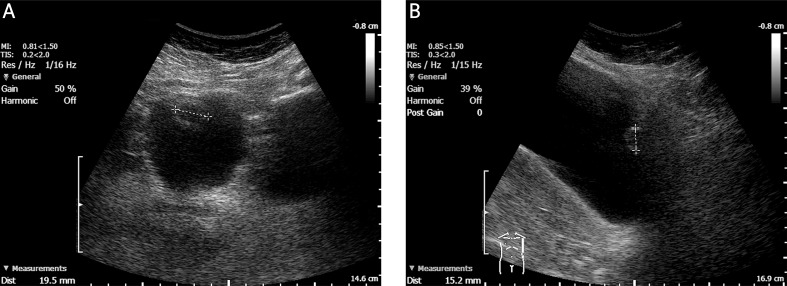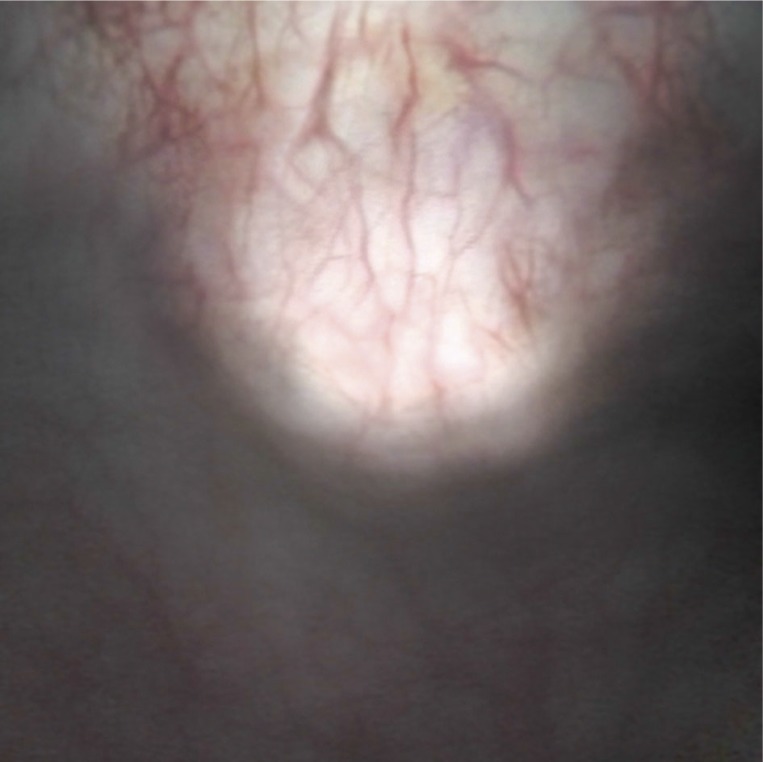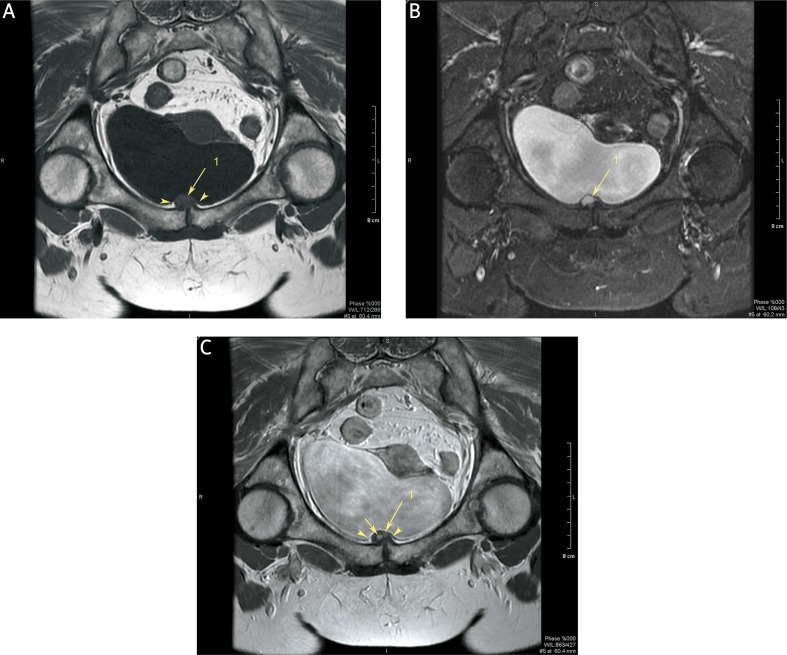Abstract
Urinary bladder sonography is a sensitive diagnostic technique used for visualizing urinary bladder tumours. The aim of our communication is to present a case of a pseudotumour of the urinary bladder originating from the symphysis pubis syndesmosis. A 58-year-old woman was seen by a urologist with symptoms of lower urinary tract infection. Urinary bladder sonography was performed, followed by magnetic resonance imaging. Sonographic images of the bladder showed an exophytic mass on the urinary bladder's anterior wall. A transurethral resection of the tumour was performed. A histopathological examination revealed a necrotic extramural mass, without traits of malignancy. The mass reappeared in the follow-up vesical sonography. Subsequently, its transurethral resection was repeated with the same histopathological findings. The next urinary bladder sonography revealed the presence of the mass again. Pelvic magnetic resonance imaging was performed, which showed advanced degenerative changes in the pubic symphysis syndesmosis that protruded into the bladder, imitating a urinary bladder tumour. To avoid unnecessary surgery, both radiologists and urologists should be made aware that there is a possibility of similar cases in patients. Magnetic resonance imaging enabled correct determination of the primary site of the growth, which, together with the histopathological examination results, influenced the choice of the implemented therapeutic procedures.
Keywords: urinary bladder, ultrasound, magnetic resonance imaging, transurethral resection of the bladder tumour
Introduction
Urinary bladder sonography is a very sensitive diagnostic technique used for visualizing urinary bladder tumours, including the most common type of bladder cancer, urothelial carcinoma (transitional cell carcinoma). The most common symptom of the latter is painless gross haematuria; however, it is also possible that only infection symptoms or only urination disorders (such as frequent urination, urinary urgency, and/or dysuria) suggest the possibility of urothelial carcinoma [1].
Case report
A 58-year-old woman was referred to a urologist with a lower urinary tract infection. Physical examination, laboratory tests, and abdominal sonography of the upper urinary tract were unremarkable. Vesical sonography showed an exophytic mass on the bladder's anterior wall (Figure 1 A–B). Urine cytology and intravenous pyelography were normal. Cystoscopy revealed a prominence of the bladder wall covered by normal mucosa (Figure 2). The lesion sample was removed through transurethral resection of the tumour (TURT). Histopathological examination showed necrotic masses filled with fibrin without traits of inflammatory infiltrate or neoplastic cells. A follow-up ultrasonography performed 3 weeks after TURT revealed a mass in the same location as the previously resected structure. Assuming that the procedure had not been radical enough, TURT was repeated. Yet, 2 weeks later, a similarly located lesion was again visible on ultrasonography. Subsequently, magnetic resonance imaging (MRI) of the pelvis was performed, showing advanced degenerative changes of the pubic symphysis with a connective tissue that cast the anterior wall of the urinary bladder (Figure 3 A–C).
Figure 1.
On ultrasonography, an exophytic, hypoechoic lesion, measuring 19 mm × 15 mm, located on the anterior-superior wall of the urinary bladder, as seen on the transverse (A) and longitudinal views (B)
Figure 2.
Cystoscopy showing a prominence of the bladder wall, very similar to that caused by the uterus, covered by normal mucosa, soft and elastic in the course of the procedure
Figure 3.
Magnetic resonance: T1-weighted image (A), T2 STIR image (B) and T1-weighted image after contrast administration (C), in an oblique coronal plane perpendicular to pubic symphysis: nodule (1) – broad base attached to the pubic symphysis and casting the anterior wall of the urinary bladder – shows enhancement predominantly in its centre (short arrow); the acute angles between the nodule and the bladder wall (arrowheads) indicate its non-vesical origin
Discussion
A review of the available literature shows this case to be the first report of a pseudotumour of the bladder ensuing from advanced degenerative changes of the pubic symphysis.
Cystoscopy revealed a submucosal anomaly; therefore, in the further diagnostic process it was possible to confine the differentiation to, sporadically described, intramural bladder tumours, most importantly to leiomyoma, their most common type [2–4]. Among other, rarely described submucosal urinary bladder tumours, there are both benign [5–12] and malignant types of tumours [13–15]. Histopathological examination of the sample is critical for the correct identification of the tumour type and for determining its character.
In the herein discussed case, as a consequence of the extraordinary results of the follow-up post-TURT sonography, which again showed the presence of a urinary bladder tumour, pelvic MRI was performed, exposing the degenerative changes in the pubic symphysis, which cast the anterior wall of the bladder. A review of the literature suggests that this is the first described case of such an advanced degenerative process in the pubic symphysis, which in a tumour-like form protruded into the bladder. The case required histopathological differentiation with other individual cases of tumour-like lesions originating from the pubic symphysis. Endoscopic diagnosis may be insufficient in this regard in some selected patients [16–19].
In this case, owing to MRI scans, the original site of the lesion was correctly determined, which, together with the histopathological examination findings, allowed for the change in the planned therapeutic proceedings. Both radiologists and urologists should be made aware that there is a possibility of similar cases in patients to avoid unnecessary surgery.
References
- 1.Messing EM, Catalona W. Urothelial tumors of the urinary tract. In: Walsh P, Retik A, Vaughan E, Wein A, editors. Campbell's urology. Ed. 7. Vol. 3. Philadelphia: W.B. Saunders Company; 1998. pp. 2327–83. [Google Scholar]
- 2.Roy MK, Joarder RH, Suruzzaman M, et al. Leiomyoma of the urinary bladder. Ymensingh Med J. 2005;14:209–11. [PubMed] [Google Scholar]
- 3.Chen CC, Huang CH, Chu CH, et al. Leiomyoma of the urinary bladder: a case report. Kaohsiung J Med Sci. 2003;19:141–5. doi: 10.1016/S1607-551X(09)70463-2. [DOI] [PubMed] [Google Scholar]
- 4.Sugimoto K, Yamamoto Y, Hashimoto K, et al. Leiomyoma of the urinary bladder treated by transurethral resection: a case report. Hinyokika Kiyo. 2007;53:251–3. [PubMed] [Google Scholar]
- 5.Rau WS, Weiss W, Dalquen P. Angiographic findings in hemangiopericitoma of the urinary bladder. Radiologe. 1979;19:234–7. [PubMed] [Google Scholar]
- 6.Liu Y, Dong SG, Dong Z, et al. Diagnosis and treatment of pheochromocytoma in urinary bladder. J Zhejiang Univ Sci B. 2007;8:435–8. doi: 10.1631/jzus.2007.B0435. [DOI] [PMC free article] [PubMed] [Google Scholar]
- 7.Kita M, Okuyama M, Azumi M, et al. Multiple paraganglioma of the urinary bladder. Hinyokika Kiyo. 2007;53:707–11. [PubMed] [Google Scholar]
- 8.Urbańczyk K, Skotniczny K, Kuciński J, Friediger J. Mesothelial inclusion cysts (so-called benign cystic mesothelioma) – a clinicopathological analysis of six cases. Pol J Pathol. 2005;56:81–7. [PubMed] [Google Scholar]
- 9.Hsiao CH, Wen YC, Lee LM. Pseudosarcomatous myofibroblastic proliferation of the urinary bladder. J Chin Med Assoc. 2008;71:431–4. doi: 10.1016/S1726-4901(08)70097-2. [DOI] [PubMed] [Google Scholar]
- 10.Huang CY, Shun CT, Huang KH, et al. Primary amyloidosis of the urinary bladder. J Formos Med Assoc. 2006;105:164–7. doi: 10.1016/S0929-6646(09)60339-9. [DOI] [PubMed] [Google Scholar]
- 11.Rosai J. Female reproductive system. In: Rosai J, editor. Surgical pathology. Vol. 2. Mosby; 2004. pp. 1483–762. [Google Scholar]
- 12.Szopiński T, Sudoł-Szopińska I, Dzik T, Borówka A. Ectopic desidual reaction in the urinary bladder presenting as a vesical tumour. J Urology. 2009;74:1232–3. doi: 10.1016/j.urology.2009.05.009. [DOI] [PubMed] [Google Scholar]
- 13.Kim JC. CT features of bladder small cell carcinoma. Clin Imaging. 2004;28:201–5. doi: 10.1016/S0899-7071(03)00150-5. [DOI] [PubMed] [Google Scholar]
- 14.Jones EC, Young RH. Myxoid and sclerosing sarcomatoid transitional cell carcinoma of the urinary bladder: a clinicapathologic and immunohistochemical study of 25 cases. Mod Pathol. 1997;10:908–16. [PubMed] [Google Scholar]
- 15.Kagota M, Irie K, Hosaka K, Takezaki T. Bladder metastasis of renal cell carcinoma; a case study. Hinyokika Kiyo. 2007;53:571–4. [PubMed] [Google Scholar]
- 16.Martel JP, Spouge AR. Gas-filled parasymphyseal pubic cyst associated with degenerative joint disease. Skeletal Radiol. 2007;36(Suppl 1):S112–5. doi: 10.1007/s00256-006-0156-7. [DOI] [PubMed] [Google Scholar]
- 17.Knowles NG, Smith DL, Outwater EK. MRI diagnosis of brown tumor based on magnetic susceptibility. J Magn Reson Imaging. 2008;28:759–61. doi: 10.1002/jmri.21441. [DOI] [PubMed] [Google Scholar]
- 18.Ergun T, Lakadamali H, Adin O. Subpubic cartilaginous cyst: incidental finding detected by abdominopelvic computed tomography. Radiat Med. 2008;26:46–9. doi: 10.1007/s11604-007-0191-x. [DOI] [PubMed] [Google Scholar]
- 19.Roslan M, Markuszewski M, Gibas A, et al. Laparoendoscopic single-site transvesical removal of mid-urethral polypropylene sling eroded into the bladder. Videosurgery and Other Miniinvasive Techniques. 2011;6:111–4. [Google Scholar]





